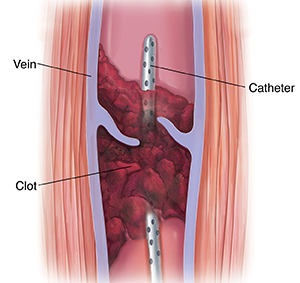Understanding Percutaneous Transcatheter Treatment of Deep Vein Thrombosis (DVT)
Understanding Percutaneous Transcatheter Treatment of Deep Vein Thrombosis (DVT)

The treatment is done with a long, thin tube (catheter). The catheter is used to get to the blood clot to help remove it or break it up. Percutaneous means that it’s done through a small cut (incision) in the skin. Your healthcare provider may use the catheter with medicine, tools, or other tiny devices (balloons, wire mesh) to treat the clot.
Why percutaneous transcatheter treatment for DVT is done
When you have DVT, a piece of the blood clot may break off and travel through your blood vessels to one of your lungs. This is a very serious and life-threatening condition called pulmonary embolism (PE). Percutaneous transcatheter treatment is done to remove the clot so this doesn’t happen.
Your healthcare provider may advise this treatment to:
Treat DVT if you can’t take blood thinner medicine
Treat DVT if you took blood thinner medicine and it didn’t work
Lessen symptoms from DVT, such as swelling
Treat a blood clot in your thigh, which is more likely to lead to serious problems
Treat a large blood clot
Decrease the risk of long-term problems with your veins
All treatments for DVT have their own risks and benefits. Ask your healthcare provider which treatment is best for you.
How percutaneous transcatheter treatment of DVT is done
The procedure is done by a healthcare provider who is a blood vessel (vascular) specialist. It can be done in several ways. He or she will make a small cut (incision) through your skin and into a blood vessel (vein) in your groin, the area between your stomach and your thigh. The healthcare provider will put a long, thin wire into the incision and, under X-ray guidance, position the wire near the clot. The healthcare provider will then insert a catheter using the wire as a guide. He or she may then send clot-dissolving medicine through the catheter. He or she may use small tools to help break up the clot. A tiny balloon or mesh may be inserted to open the vein.
Risks of percutaneous transcatheter treatment of DVT
All treatments have risks. The risks of this procedure include:
Too much bleeding
Infection
Damage to the vein
Clot breaking off and traveling to other areas or organs
Reaction to anesthesia
Another DVT forming
Your risks vary depending on your overall health, how long you’ve had the clot, and where it is in your body. Ask your healthcare provider which risks apply most to you.
Updated:
March 21, 2017
Sources:
Overview of the Treatment of Lower Extremity Deep Vein Thrombosis (DVT). UpToDate
Reviewed By:
Dozier, Tennille, RN, BSN, RDMS,Image reviewed by StayWell medical illustration team.,Mancini, Mary, MD